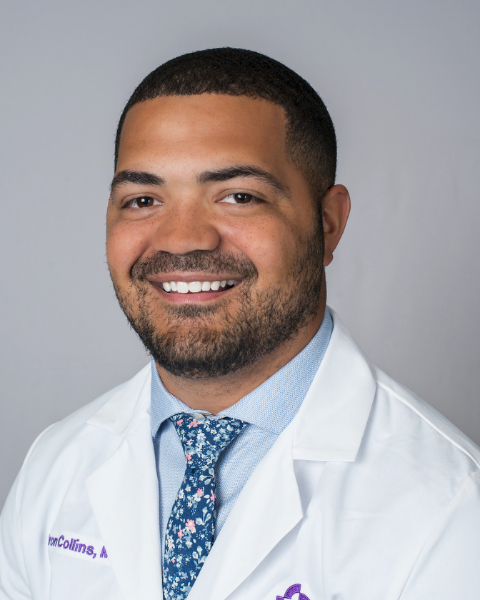PQA 03 - PQA 03 Gynecological Cancer, Pediatric Cancer, and Professional Development Poster Q&A
3492 - Patterns of Care and Clinical Outcomes for Pediatric Wilms Tumor Treated with Proton Therapy on the Multi-Institutional Pediatric Proton Consortium Registry
Monday, September 30, 2024
8:00 AM - 9:00 AM ET
Location: Hall C
Screen: 17

Erron Collins, MD
WellStar Health System
Marietta, GA
Presenter(s)
E. B. Collins1, B. R. Eaton2, N. N. Laack II3, R. P. Ermoian4, S. L. Wolden5, A. C. Paulino6, C. E. Hill-Kayser7, S. A. Mihalcik8, D. J. Indelicato9, V. S. Mangona10,11, and T. I. Yock12; 1Morehouse School of Medicine, Atlanta, GA, 2Department of Radiation Oncology, Winship Cancer Institute of Emory University, Atlanta, GA, 3Department of Radiation Oncology, Mayo Clinic, Rochester, MN, 4Department of Radiation Oncology, University of Washington/ Fred Hutchinson Cancer Center, Seattle, WA, 5Memorial Sloan Kettering Cancer Center, New York, NY, 6Department of Radiation Oncology, The University of Texas MD Anderson Cancer Center, Houston, TX, 7Department of Radiation Oncology, Perelman School of Medicine, University of Pennsylvania, Philadelphia, PA, 8Department of Radiation Oncology, Northwestern Medicine, Feinberg School of Medicine, Chicago, IL, 9Department of Radiation Oncology, University of Florida College of Medicine, Gainesville, FL, 10MD Anderson Cancer Center, Houston, TX, 11Texas Center for Proton Therapy, Texas Oncology, Irving, TX, 12Department of Radiation Oncology, Massachusetts General Hospital, Harvard Medical School, Boston, MA
Purpose/Objective(s): To evaluate patterns of care and clinical outcomes among Wilms tumor patients treated with proton beam radiation therapy (PBT). Materials/
Methods: Eligible patients were children <22 years old with Wilms tumor treated with proton therapy and enrolled on the Pediatric Proton/Photon Consortium registry. Patient demographic, disease, treatment, and outcome data were prospective collected and are reported in descriptive statistics.
Results: Eighteen patients received proton therapy from September 2012- February 2024 at 11 institutions. Median age at diagnosis was 4.3 years (range 1.2 – 17.3). Patients were most commonly White (n=12), Non-Hispanic or Latino (N=11), Male (n=10), with favorable histology (n=15) and Stage III (n=7) or Stage IV (n=8) disease at diagnosis. Eight patients (44%) were treated for relapsed disease. Patients were treated to the abdomen (n=12, median dose 19.5 GyRBE (range 10.5-36), thorax (n=8, median dose 15.8 Gy(RBE) (range 12-39.6), or other metastases (n=1, 25.2 GyRBE). Pencil beam scanning was most commonly used (n=16). Three patients received combination photon-proton radiation, and two required a proton replan during treatment due to moving an extremity position (n=1) or change in bowel gas pattern (n=1). All patients completed the full prescribed dose with no recorded delays or breaks in treatment. Median follow-up of 3.1 years (range 0.3-8.7 years). Among 12 patients with complete follow-up data, 2/6 patients treated for relapse and 1/6 patients treated at initial diagnosis experienced a distant progression at a median time of 21 months (range 4-38 months) from proton therapy. Al last follow-up 11 (83%) patients are alive with no evidence of disease, 1 patient has stable disease, and 1 patient has died of disease.
Conclusion: his multi-institutional study is the first to report clinical outcomes for pediatric Wilms tumor patients treated with proton therapy. Results demonstrate that proton therapy is feasible and well tolerated for Wilms Tumor abdominal and thoracic targets. Clinical outcomes are as expected for this heterogenous and high-risk population.
Purpose/Objective(s): To evaluate patterns of care and clinical outcomes among Wilms tumor patients treated with proton beam radiation therapy (PBT). Materials/
Methods: Eligible patients were children <22 years old with Wilms tumor treated with proton therapy and enrolled on the Pediatric Proton/Photon Consortium registry. Patient demographic, disease, treatment, and outcome data were prospective collected and are reported in descriptive statistics.
Results: Eighteen patients received proton therapy from September 2012- February 2024 at 11 institutions. Median age at diagnosis was 4.3 years (range 1.2 – 17.3). Patients were most commonly White (n=12), Non-Hispanic or Latino (N=11), Male (n=10), with favorable histology (n=15) and Stage III (n=7) or Stage IV (n=8) disease at diagnosis. Eight patients (44%) were treated for relapsed disease. Patients were treated to the abdomen (n=12, median dose 19.5 GyRBE (range 10.5-36), thorax (n=8, median dose 15.8 Gy(RBE) (range 12-39.6), or other metastases (n=1, 25.2 GyRBE). Pencil beam scanning was most commonly used (n=16). Three patients received combination photon-proton radiation, and two required a proton replan during treatment due to moving an extremity position (n=1) or change in bowel gas pattern (n=1). All patients completed the full prescribed dose with no recorded delays or breaks in treatment. Median follow-up of 3.1 years (range 0.3-8.7 years). Among 12 patients with complete follow-up data, 2/6 patients treated for relapse and 1/6 patients treated at initial diagnosis experienced a distant progression at a median time of 21 months (range 4-38 months) from proton therapy. Al last follow-up 11 (83%) patients are alive with no evidence of disease, 1 patient has stable disease, and 1 patient has died of disease.
Conclusion: his multi-institutional study is the first to report clinical outcomes for pediatric Wilms tumor patients treated with proton therapy. Results demonstrate that proton therapy is feasible and well tolerated for Wilms Tumor abdominal and thoracic targets. Clinical outcomes are as expected for this heterogenous and high-risk population.
